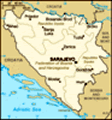Advertisement
Published: August 26th 2016
Today was occupied with driving from Kotor to Sarajevo. Although it sounds rather mundane, it was in fact a journey of great beauty and pleasure. We had programmed our GPS units to take us through Durmitor National Park, and that trip was magnificent, and somewhat unexpectedly so. We had anticipated mountains but did not know that most of the trip through the park would be on very narrow roads wide enough really for one car but with two-way traffic. Rounding bends with no visibility around the bend was frequently an adventure. But with risks come great rewards. This was one of the most spectacular travel days we have had, and I think by general consensus the best of this trip. The narrow winding road snakes upward to high mountain valleys, meadows, and bowls, punctuated along the way with marvelous displays of the geological forces that have formed this region. The mountains are mostly limestone, meaning that during the Triassic Era this was all a gigantic coral reef. Hard to imagine that when you look at the landscape and see the size of the Durmitor Massif, completely included within the park, and comprising some 48 mountain peaks over 200 m in height,
13 glacial cirques, 18 glacial lakes (many looking pretty depleted of water during our visit), three huge canyons, and 748 springs. On the way up, we saw several stopped cars with people out collecting wild raspberries that grew near the road. Unlike Triglav in Slovenia, we did not follow a river or stream, but just followed a road which I think was basically the path of least resistance. Coming down the other side of the park, we went through many bare rock tunnels and switchbacks, with some switchbacks occurring WITHIN the tunnel and in one case a tunnel that include both a switchback and a road junction, complete with stop sign. And a partially collapsed roof, fortunately a past occurrence. There were sheepherders with their dogs, cattle herders, and at one point a little black and white dog in a remote area who looked perfectly fine and watched us from a distance with wagging tail, but with no one around.
As we left the park, we traveled along the Tara River and through its canyon, at last crossing it into Bosnia and Herzegovina. The contrast was immediate and jarring (quite literally). We went from pretty good roads to a
barely paved travesty of transportation. B&H has only 84 km of paved 4-land road, and we did not encounter any today. We drove through rain along poor roads which gradually improved as we neared Sarajevo, but were never very good. As we drove into Sarajevo, the rain continued, and evidence of the past war was still visible everywhere, the combination lending a gritty and somewhat desperate feel to the city. Home of the 1984 Olympics, it would not be considered for such an event today. The country is poor, and is going to be a long time recovering from the war.
On our way to dinner, we stopped by the site of the assassination of Archduke Franz Ferdinand, the event which resulted in the sort of World War I. The story of the assassination reads like a farce. A number of Serbian nationalist conspirators were armed with poor quality guns, scarce ammunition, grenades, and cyanide capsules for suicide. As the convoy of the Archduke, one of them tossed his grenade, but it bounded off the rear cover on the Archduke's car and under the following car, where it exploded, injuring 16-20 people. The grenade thrower swallowed his cyanide and
threw himself into the nearby Miljacka River, Unfortunately for him, the cyanide only caused vomiting, and the river was only about 6" deep, so he was quickly grabbed and beaten before being taken off to jail. Ferdinand proceeded with his wife to a reception at the Town Hall. There, after the planned meeting with the mayor, they had a discussion of what to do next. The suggestion was made that they should stay in the Town Hall while troops were brought in to line the street along which the motorcade would proceed. The idea was vetoed because soldiers coming from maneuvers would not be in the proper dress uniforms. While vetoing the idea, the governor-general asked "Do you think Sarajevo is full of assassins?" The Archduke and his wife Sophie decided to go visit the wounded in the Sarajevo Hospital. Governor-General Potiorek changed the route to avoid the center of the city, but somehow no one told the driver of the Archduke's car, so he turned right off of Appel Quay. When directed he stopped to turn around, and at the moment Gaavrilo Principe, one of the conspirators, stepped out of the crowd and fired two shots, intending to kill
the governor-general and the Archduke. Instead, he short the Archduke in the neck immediately after shooting Sophie in the abdomen. She died on the way to the hospital, and the Archduke, whose jugular was severed, died about 10 minutes later. The austro-Hungarian government made some ridiculous demands on Serbia (home the conspirators, but otherwise having nothing to do with the assassination), Serbia made a ridiculous response. Days later, Serbian reservists accidentally crossed into Austro-Hungarian territory on the Danube, and shots were fired in the air. This was erroneously reported Emperor Franz Joseph as a considerable skirmish. He declared war and reminded allies of their treaty responsibilities. General mobilization ensued, and in the resultant World War I some 20 million people died. Failure to properly deal with the settling of that war led to the rise of Hitler and the Nazis, and thus World War II with its resultant >60 million deaths.
Advertisement
Tot: 0.068s; Tpl: 0.013s; cc: 14; qc: 23; dbt: 0.0421s; 1; m:domysql w:travelblog (10.17.0.13); sld: 1;
; mem: 1.1mb



















